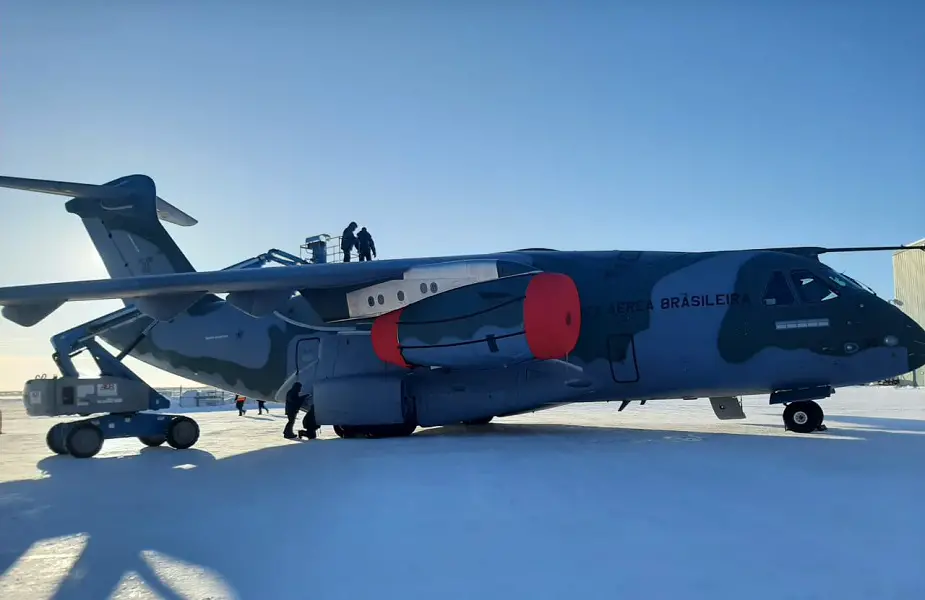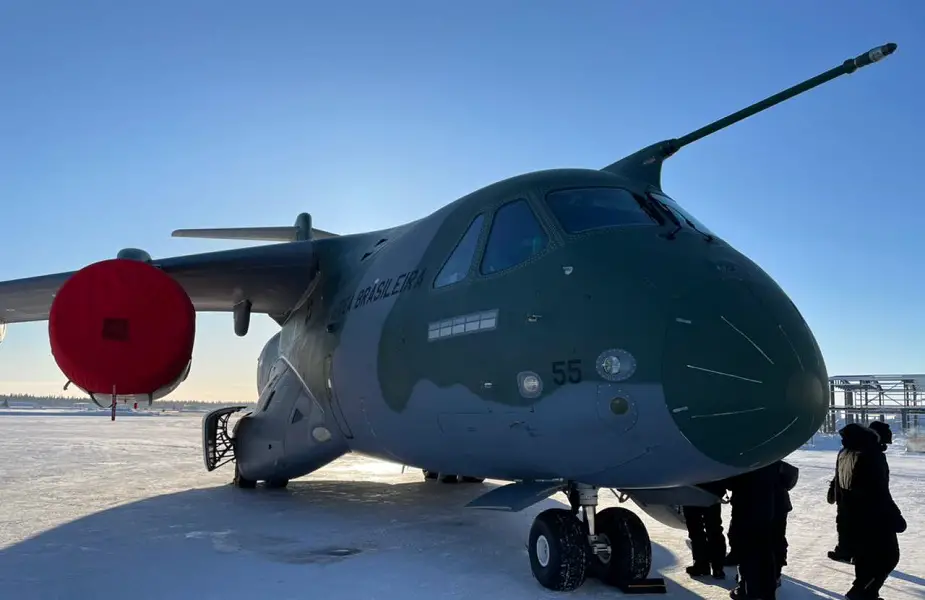Breaking news
Brazilian Air Force and Embraer test KC-390 Millennium in extreme cold.
The Brazilian Air Force (FAB) and Embraer started, on February 8, the tests of extreme cold, Cold Soak , of the aircraft KC-390 Millennium in the United States (USA). The mission focuses on verifying the integration of all subsystems and the robustness of the new FAB freighter in a hostile environment, with extremely low temperature conditions.
Follow Air Recognition on Google News at this link
 In Fairbanks, the aircraft was exposed, for a long period, to a climatic environment favorable to the tests, reaching a peak of -37.8 ° C with a thermal sensation of - 47.8 ° C. After the requested exposure time, operational checks of the aircraft were conducted to verify the correct functionality of several systems, such as: avionics, electric, hydraulic, flight controls, fuel, engines, Auxiliary Power Unit (APU) and radar (Picture source: Lieutenant Colonel Emerson / COPAC)
In Fairbanks, the aircraft was exposed, for a long period, to a climatic environment favorable to the tests, reaching a peak of -37.8 ° C with a thermal sensation of - 47.8 ° C. After the requested exposure time, operational checks of the aircraft were conducted to verify the correct functionality of several systems, such as: avionics, electric, hydraulic, flight controls, fuel, engines, Auxiliary Power Unit (APU) and radar (Picture source: Lieutenant Colonel Emerson / COPAC)
The activity is managed by the Coordinating Committee of the Combat Aircraft Program (COPAC) and includes representatives from the Institute for Promotion and Industrial Coordination (IFI), test engineers from the Flight Research and Testing Institute (IPEV) and members of Embraer. The aircraft operation was supported by the crew of the First Troop Transport Group (1st GTT) - Zeus Squadron.
Unlike an environmental qualification regarding the component, the Cold Soak test aims to investigate, in terms of the system, the effect of exposing the aircraft to extremely low temperatures, for a considerable time on the ground, a situation in which the systems failure may lead to Service Difficulty events, in which the aircraft is unable to operate.
The activity started with the arrival of the KC-390 in the city of Jacksonville (FL), on February 8, where the specialized team of Embraer and FAB, among engineers, technicians and crew members met. On the same day, the aircraft took off to Moses Lake (WA) to make the first transfer to Fairbanks (AK). It is worth noting that this stage lasted 6h28min, which represents the longest operational flight time of the KC-390, on a single route, already completed and explains the autonomy and range of the aircraft, essential factors for the fulfillment of the logistical air transport mission .
The C-390 is a tactical transport jet aircraft designed to set new standards in its category. Some of the strong aspects of the aircraft are increased mobility, rugged design, higher flexibility, state-of-the-art proven technology and easier maintenance. Flying faster and delivering more cargo, both the C-390 Millennium and the KC-390 variant are the right sized platform for major deployment scenarios. Minimized interventions and on condition maintenance combined with highly reliable systems and components support the reduced downtime and costs, contributing to outstanding availability levels and low life cycle costs.
 Unlike an environmental qualification regarding the component, the Cold Soak test aims to investigate, in terms of the system, the effect of exposing the aircraft to extremely low temperatures, for a considerable time on the ground, a situation in which the systems failure may lead to Service Difficulty events, in which the aircraft is unable to operate (Picture source: Lieutenant Colonel Emerson / COPAC)
Unlike an environmental qualification regarding the component, the Cold Soak test aims to investigate, in terms of the system, the effect of exposing the aircraft to extremely low temperatures, for a considerable time on the ground, a situation in which the systems failure may lead to Service Difficulty events, in which the aircraft is unable to operate (Picture source: Lieutenant Colonel Emerson / COPAC)
In Fairbanks, the aircraft was exposed, for a long period, to a climatic environment favorable to the tests, reaching a peak of -37.8 ° C with a thermal sensation of - 47.8 ° C. After the requested exposure time, operational checks of the aircraft were conducted to verify the correct functionality of several systems, such as: avionics, electric, hydraulic, flight controls, fuel, engines, Auxiliary Power Unit (APU) and radar.
Lt. Col. Aviator Carlos Vagner Ottone Veiga, from the Zeus Squadron, is on the mission and stressed the importance of testing. “The test results will be important to continue with the certification of the aircraft in this condition, a big step so that the missions of the Brazilian Antarctic Program (PROANTAR) with the KC-390 can take place in the near future. It is worth mentioning that the Squadron reached the longest flight mark with this aircraft, in the stretch between Jacksonville and Moses Lake, showing the enormous capacity of this vector ”, he explained.
For Lieutenant-Colonel Engineer Emerson Gonçalves de Souza, from COPAC, who is also part of the team, the Cold Soak test is another step in aircraft certification. "The performance of the test represents an important milestone in the process of military development and certification of the KC-390 aircraft, which aims to ensure that this important Air Force vector will be able to operate efficiently in low temperature conditions, meeting the requirements established by the Air Force for your job, ”he said.
Due to exposure to the extreme cold, the checks took place in a measured and thorough manner, in order to guarantee the safety of the testing team and the quality of the results obtained. The long journey of tests allowed the collection of various data that will be used to prove the aircraft's robustness, as well as for the improvement and maturation of the evaluated systems
“It was a great joy for Embraer's team of engineers and mechanics to observe the result of years of development. The aircraft operated very well and, with the test result, we will be able to increase safety and efficiency when the KC-390 operates at low temperatures ”, commented Embraer engineer Guilherme Moreschi Valente dos Santos.
The success of the mission was a fundamental step towards continuing the certification of the KC-390 Millennium aircraft, ensuring the integration of systems, robustness and safety throughout the operational envelope. It is also noteworthy that these characteristics will assist in fulfilling the strategic missions of PROANTAR.
 The success of the mission was a fundamental step towards continuing the certification of the KC-390 Millennium aircraft, ensuring the integration of systems, robustness and safety throughout the operational envelope. It is also noteworthy that these characteristics will assist in fulfilling the strategic missions of PROANTAR (Picture source: Lieutenant Colonel Emerson / COPAC)
The success of the mission was a fundamental step towards continuing the certification of the KC-390 Millennium aircraft, ensuring the integration of systems, robustness and safety throughout the operational envelope. It is also noteworthy that these characteristics will assist in fulfilling the strategic missions of PROANTAR (Picture source: Lieutenant Colonel Emerson / COPAC)



















